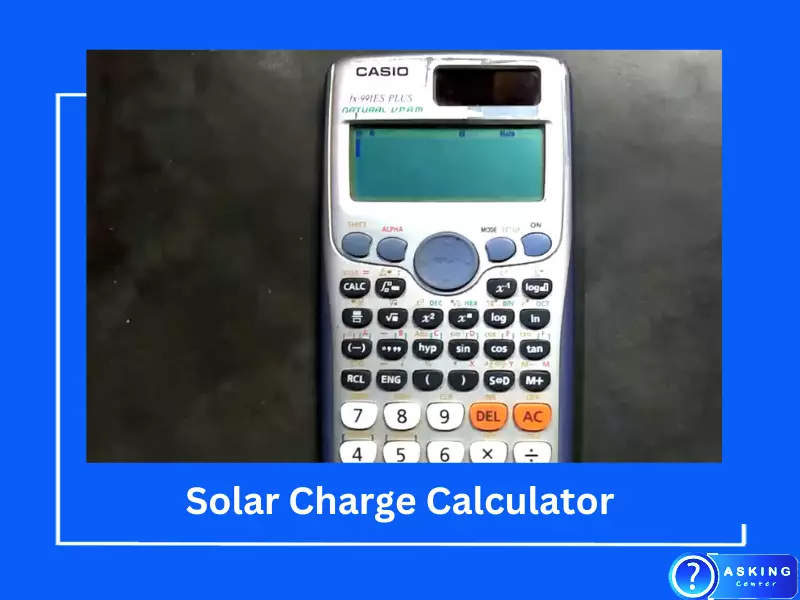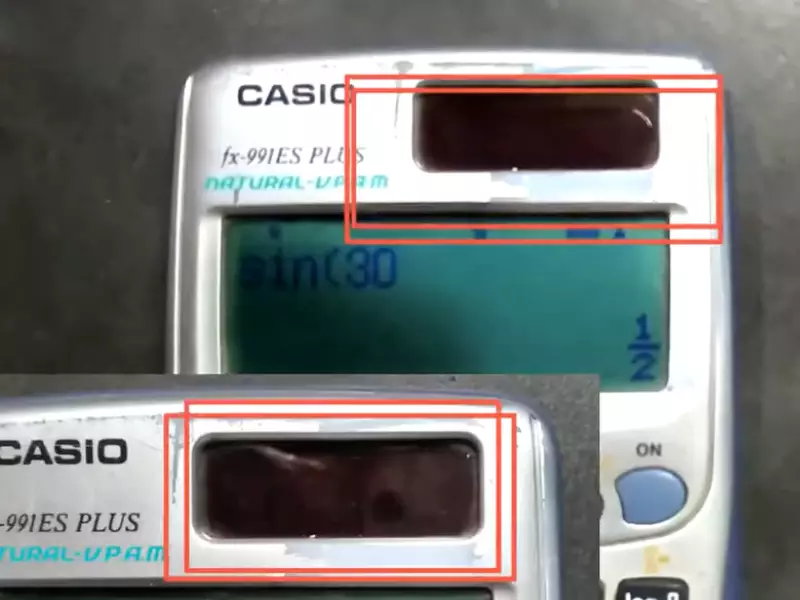Solar power, as an abundant and renewable source of energy, has found widespread use in various applications, one of which is powering batteries. With advancements in technology, harnessing solar power efficiently has become increasingly vital. At the heart of this process are solar panels, devices designed to convert the sun’s energy into electricity.
The conversion of solar energy to electricity and its subsequent use in charging batteries involves precise calculations. A solar charge calculator is an indispensable tool for this. It assists in determining how long it would take a solar panel to charge a battery, considering the wattage of the solar panel and the voltage of the battery.
Solar charge calculations are a fascinating aspect of solar power utilization. As you delve deeper into this article, you will find intricate details that shed light on this subject. This comprehensive guide will empower you with the knowledge to make informed decisions in your solar power applications.
Basics of Solar Power
Solar power systems convert sunlight into electricity through a process called photovoltaic effect. Solar panels comprise a multitude of solar cells that work in unison to generate electrical power. Each solar cell generates a small amount of electricity when sunlight hits its surface. It’s the cumulative effort of these cells that makes solar panels a viable source of power.

Components of a Solar Power System
Solar power systems, though simple in theory, are a complex assembly of different components. Each part of the system plays a crucial role in ensuring effective and efficient energy conversion and utilization.
Solar Panels
Solar panels are the heart of the system, converting sunlight into electricity. They are made up of several smaller units called solar cells, which are essentially semiconductors that absorb light and convert it into electricity.
Charge Controller
The charge controller manages the power going into the battery bank from the solar panels. It ensures the batteries are charged efficiently and safely, protecting them from overcharging or undercharging. It also helps prolong the battery life by preventing rapid charge and discharge cycles.
Battery
The battery, or often a battery bank in larger systems, stores the electricity generated by the solar panels. The size and type of the battery are critical. Lead-acid and lithium-ion batteries are commonly used in solar applications.
Inverter
The inverter is a device that converts the direct current (DC) electricity stored in the batteries into alternating current (AC) electricity, which is the standard electrical current used by most household appliances.
Understanding Battery Charging with Solar Power
Battery charging through solar power is a complex process that relies on multiple factors, including the efficiency of the solar panels, the capacity and health of the batteries, and the availability of sunlight.
Charging Process
In the charging process, solar panels absorb sunlight and convert it into DC electricity. This electricity flows to the batteries through a charge controller. The charge controller maintains an appropriate charging rate to ensure the batteries are charged efficiently and safely.
Factors Affecting Charging
The rate at which a battery charges depends on the solar panel’s power output, the battery’s capacity and voltage, and the amount of sunlight available. Understanding these factors is essential to accurately calculate charging times and ensure optimal system performance.
How Different Panels Charge Battery
Solar panels come in several types, each with unique characteristics that affect their efficiency and, consequently, the charging process.
Monocrystalline Panels
Monocrystalline panels are the most efficient type. They’re made of single-crystal silicon, allowing for a high level of purity. This high purity means more room for the electrons to move, resulting in a higher efficiency.
Polycrystalline Panels
Polycrystalline panels are made from multiple silicon fragments melted together. They are slightly less efficient than monocrystalline panels due to the grain boundaries present in the silicon, which slightly impede the movement of electrons.
Thin-Film Panels
Thin-film panels are the least efficient but are also the most affordable. They’re made by placing one or more thin layers of photovoltaic material on a substrate. Despite their lower efficiency, they perform better in lower-light conditions and higher temperatures.

Understanding Solar Charge Calculators
Solar charge calculators are indispensable tools that help users optimize their solar power systems. These digital applications simplify complex calculations needed to determine how a solar panel system will perform under different conditions.
Function of Solar Charge Calculators
Solar charge calculators estimate how long it will take for a solar panel to charge a battery, given certain conditions. Users input data such as the power rating of the solar panel, the battery’s voltage and capacity, and the average hours of sunlight per day. The calculator uses this data to provide an estimated charging time.
Importance of Solar Charge Calculators
Solar charge calculators can aid in the design and implementation of solar power systems by providing estimates of system performance under different conditions. They can help in determining the optimal number and type of solar panels needed, the size of the battery required, and how weather conditions can affect the system’s performance.
How Battery Charging Time Is Calculated
Calculating battery charging time accurately is essential to ensure the smooth operation of a solar power system. Here’s a closer look at the factors involved in this calculation and how they interact:
Understanding the Formula
The formula for calculating battery charging time is based on the capacity of the battery, the power output of the solar panel, and the average sunlight hours per day. It can be expressed as follows:
Battery charging time (hours) = Battery capacity (Ah) x Battery voltage (V) / Solar panel output (W) x Sunlight hours per day
Breakdown of the Formula Components
- Battery Capacity (Ah): This is the total amount of energy the battery can store. A higher capacity means more storage but also a longer charging time.
- Battery Voltage (V): This is the difference in electric potential between the battery’s two terminals. It’s a critical factor in determining the energy a battery can deliver.
- Solar Panel Output (W): This is the amount of power the solar panel can produce under ideal conditions. It’s determined by the panel’s size and efficiency.
- Sunlight Hours per Day: This is the average number of hours the solar panel receives peak sunlight. It can vary depending on the location and time of year.
Factors Affecting Solar Panel Charging Efficiency
Several factors can affect the efficiency of a solar panel when charging a battery. Understanding these factors can help users optimize their solar power systems and achieve better performance.
Amount of Sunlight
The amount of sunlight the solar panel receives directly impacts its power output. More sunlight means more power. This is why solar panels are less effective on cloudy days or during winter months when days are shorter.
Angle and Orientation of Solar Panels
The angle and orientation of solar panels can significantly affect their efficiency. Panels should be positioned to maximize exposure to sunlight throughout the day. In the Northern Hemisphere, for instance, panels should typically face south.
Temperature
Solar panels actually become less efficient as temperature increases. This is due to the physical properties of the semiconductors used in the panels. That’s why it’s essential to provide adequate ventilation to help cool solar panels, especially in hot climates.

State of the Battery
The state of the battery can also impact the charging efficiency. An older battery or a battery in a poor state of health may not hold a charge as effectively as a new or well-maintained battery.
What Affects Charging Time
The time it takes to charge a battery using solar power depends on several variables:
External Environmental Factors
These include the amount of sunlight and atmospheric conditions. For instance, charging time will be longer on cloudy days compared to sunny days.
Solar Panel Specifications
The power output of the solar panel affects how quickly it can charge a battery. Panels with a higher wattage will charge batteries faster.
Battery Specifications
The battery’s capacity and initial state of charge will affect how long it takes to fully charge. A larger capacity battery or a battery that is heavily discharged will take longer to charge.
Efficiency of the Charge Controller
Charge controllers regulate the flow of electricity from the solar panels to the battery. Higher-quality charge controllers can improve the charging process’s efficiency, reducing the charging time.
Specific Examples of Charging Times
Understanding the approximate charging time for different battery and solar panel configurations is crucial for planning and managing a solar power system.
How Long Will It Take For a 5V Battery To Be Charged With 100W Panel?
Assuming an average of 5 hours of peak sunlight per day and a 5V, 20Ah battery, the charging time can be calculated as follows:
Battery charging time (hours) = 20Ah x 5V / 100W x 5 hours = 2 hours
How Long Will It Take For a 12V Battery To Be Charged With 100W Panel?
For a 12V, 50Ah battery and the same sunlight conditions:
Battery charging time (hours) = 50Ah x 12V / 100W x 5 hours = 12 hours
These examples assume optimal conditions. Actual charging times will vary based on factors such as weather, battery health, and system efficiency.
How to Calculate the Number of Solar Panels Required for a Specific Battery
To determine the number of solar panels needed to charge a specific battery, you need to consider the battery’s capacity, the panel’s output, and the average hours of sunlight.
To Charge A 100Ah Battery, How Many Solar Panels Are Required?
Assuming we have a 100Ah, 12V battery and a 100W solar panel, and 5 hours of peak sunlight:
Number of panels = Battery capacity (Ah) x Battery voltage (V) / (Solar panel output (W) x Sunlight hours per day) = 100Ah x 12V / (100W x 5 hours) = 2.4
So, three 100W panels would be required to charge the battery within one day under ideal conditions.
Common Problems in Solar Battery Charging
Despite the advances in solar technology, problems can still occur during the charging process. These can include:
Overcharging
Overcharging happens when the battery is charged beyond its capacity. This can damage the battery and reduce its lifespan. A quality charge controller can prevent overcharging by regulating the current flowing to the battery.
Undercharging
Undercharging occurs when the battery is not charged fully. This can happen if the solar panels do not receive enough sunlight or if the system is not sized correctly. Regularly undercharging a battery can also shorten its lifespan.
Inefficient Charging
Inefficient charging can occur due to poor system design, like incorrectly angled solar panels or a lack of ventilation causing overheating. Inefficiencies can also be caused by a poor-quality charge controller.

Possibility of Charging Dead Batteries with Solar Panels
Solar panels can charge a dead battery, but the process may be inefficient, and it can be challenging to bring the battery back to its full capacity.
Is It Possible To Charge A Dead Battery Using A Solar Panel?
Yes, it’s possible, but it requires careful monitoring to avoid damaging the battery further. The process is slow and may take several days, depending on the battery’s condition and the solar power available.
Tips for Maintaining Battery Health
- Regularly check the battery’s state of charge and avoid letting it discharge fully.
- Ensure the battery is stored in a cool and dry place.
- Regularly clean the battery terminals to prevent corrosion.
- Use a charge controller to prevent overcharging or undercharging.
Practical Tips to Optimize Solar Panel Charging
Here are some tips to maximize the efficiency of your solar panel charging system:
Positioning of Solar Panels
Ensure your solar panels are positioned to receive maximum sunlight throughout the day. In the Northern Hemisphere, this usually means facing the panels south.
Regular Maintenance of Solar Panels and Batteries
Clean solar panels regularly to remove dust and debris, and check batteries for signs of wear or damage.
Using Quality Components
Invest in high-quality solar panels, charge controllers, batteries, and inverters. Quality components not only improve system efficiency but also tend to have longer lifespans, reducing the need for frequent replacements.
Optimize Wiring and Connections
Ensure proper wiring and connections between the solar panels, charge controller, batteries, and inverter. Poor connections can lead to energy losses and reduced system performance.
Monitor and Adjust System Settings
Regularly monitor your solar power system’s performance and make necessary adjustments. Check the charge controller settings, battery voltage, and ensure the system is operating optimally.
Consider Energy Storage Options
If you have excess energy generated by your solar panels, consider utilizing energy storage solutions such as solar batteries. These batteries can store excess energy during the day for use during nighttime or when sunlight is limited.
Key Features to Look for in a Solar Charge Calculator
- Compatibility: Ensure the calculator supports the battery types and voltage used in your system.
- Efficiency Factors: Look for calculators that consider efficiency losses due to factors like temperature and wiring resistance.
- Customization: Seek calculators that allow customization based on location-specific data and system configurations.
- User-Friendly Interface: Opt for calculators with intuitive interfaces that are easy to navigate and input data.
- Additional Features: Some calculators may offer additional features like data logging, graphical representations, or system optimization suggestions.
Conclusion
Understanding solar panel charging calculations and utilizing solar charge calculators is essential for designing, optimizing, and managing solar power systems. By comprehending factors such as battery capacity, solar panel output, and sunlight hours, you can estimate charging times and determine the number of solar panels needed for a specific battery.
Consider factors like battery aging and maintenance, the possibility of charging dead batteries, and practical tips for optimizing solar panel charging. Lastly, select a reputable solar charge calculator that aligns with your system requirements to ensure accurate calculations and efficient solar power utilization.
